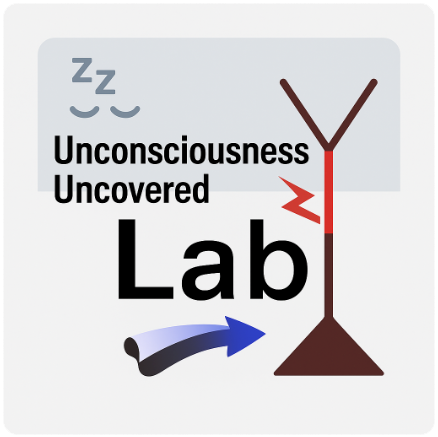
Website currently under construction!

Best article prize Kathi Hetzinger-Wittmann, MB 25 class of 2024
Figure 1: Layer 5 pyramidal neuron.
[1] Apical dendrites: input from cortex;
[2] Cell body (soma);
[3] Basal dendrites: input from sensory organs;
[4] Axon: output.
Many of us have experienced it and many more hope that they never will: the complete loss of consciousness that comes with general anesthesia. This medical procedure has now been practiced for over 150 years – thankfully one might add: just imagine surgery without it. And although anesthesia does have its risks and side effects it works well. What most people don’t know however is that up to this day it is not really understood why and how anesthesia does work. We know a few things, for example that drugs like benzodiazepines target special receptors in our brain that inhibit the transmission of neural signals. But anesthesia doesn’t simply produce a brain without any signaling. Actually, there are as many incoming signals from our sensory organs during anesthesia as without it – only we are not conscious of any of them. Why is that?
The research group of Professor Matthew Larkum at Humboldt-Universität (HU) in Berlin thinks that they are getting closer to an answer. They suspect that a special kind of neuron in the brain is responsible for our conscious perception, and the loss of it: the so-called pyramidal neuron in the 5th layer of the cortex. These strangely shaped cells sit directly under our skull in the outermost area of the brain: the cortex. Out of the six cortex layers layer 5 (L5) is the main output layer, it carries information on to other brain areas like the thalamus for example – our main relay station for signals from and to about everywhere. But the L5 pyramidal neuron gets a lot of input, too: from the thalamus as well, but it also connects to the cortex itself. And this is where it gets interesting: the HU group thinks that within each of these single pyramidal cells a connection of different types of signals happens: input from the outside (via the thalamus, arriving at the base of the cell) and input from the cortex (context and/or feedback information, arriving at the top) meet inside the cell (see figure 1).
If they arrive at the same time there is a match: the signals amplify each other and the cell creates output: a signal is produced, information can be exchanged in a complex thalamo-cortical loop – and we perceive. If there is no match, there is no signal, no perception. This is exactly what happens when the top and the base of the pyramidal cell are decoupled, i.e. when the incoming signals are unable to meet: for example, when an anesthetic drug inhibits the flow of the signals.
This is an interesting hypothesis – but now, of course, it has to be tested. One idea is to directly induce the decoupling of L5 pyramidal cells artificially. You would need a way to switch off the connection in these cells without changing anything else in the brain: otherwise, that might be responsible for any loss of consciousness, and you would have gained nothing. There are ways to achieve this, and one is called chemogenetics.
Figure 2: Mouse brain with fluorescent L5 pyramidal neurons.
Image: João Pedro Parreira Rodrigues, HU Berlin.
In Berlin researcher João Pedro Parreira Rodrigues from Brazil is using chemogenetics to modify the brain of mice in such a way that a drug called deschloroclozapine (DCZ) specifically targets L5 pyramidal neurons. (It is actually a subset of L5 pyramidal neurons that is targeted, so-called pyramidal track (PT) neurons, that project mainly subcortically to the thalamus, producing the thalamo-cortical loop thought to be responsible for consciousness.) DCZ will decouple the apical and basal dendrites of the cells for two to four hours. The big question is: Will the mice be unconscious? And if so, are they anesthetized or just asleep? This you can find out by turning them on their back: if they are just asleep they will still show their natural reflex and turn around to their paws. During the experiment the mice’s brain waves are recorded, and after the experiment the location of all neurons with DCZ-sensitive receptors has to be confirmed (see infobox 2) – in order to make sure that the effect of unconsciousness really was due to the injection of DCZ, that the receptors it blocks really were expressed in the cortex, and that there were no other unwanted side effects.
This is an ongoing project that is still in the data collection phase. But first results show that the mice really do fall asleep just by decoupling L5 pyramidal neurons. And there seems to be a gradual shift from sleep to anesthesia depending on the number of pyramidal cells that are decoupled by DCZ. So far only about 20 percent of L5 pyramidal neurons produce the new receptors. The next step therefore would be to use another mouse line, raise the percentage of L5 pyramidal neurons that can be decoupled to 80 percent, and see whether that results in more deeply anesthetized mice. So there is still a lot of work to be done, but if the hypothesis of the HU research group turns out to be true, this would be a giant step towards understanding anesthesia. And if we know what happens in our brain during unconsciousness, we can not only use this knowledge to make anesthesia work even better and have less side effects – it may ultimately even lead to understanding consciousness itself.